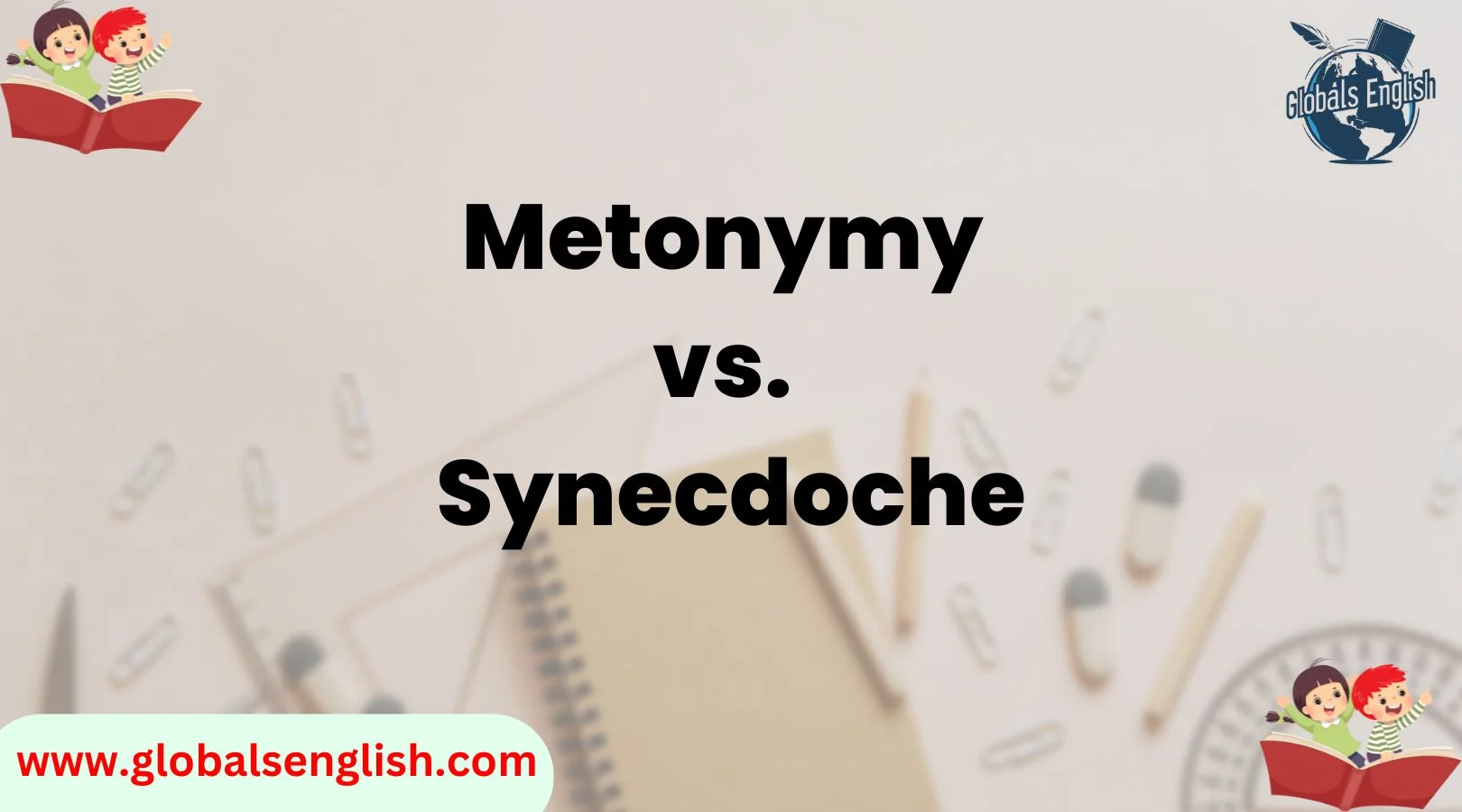Metonymy and synecdoche are two figures of speech that often confuse even seasoned writers and language lovers. While they both involve substituting one thing for another, the key difference lies in how they make those connections.
Understanding these two rhetorical devices can significantly enhance your writing, allowing you to express ideas more vividly and precisely.
Whether you’re a student, a writer, or someone simply curious about the nuances of language, this article will guide you through the definitions, examples, and practical uses of metonymy and synecdoche.
In literature, metonymy and synecdoche are essential tools for creating layers of meaning that engage the reader or listener in unexpected ways. These figures of speech aren’t just reserved for highbrow literature either.
You’ll find them all around you—whether in advertising, media, or even casual conversations. By mastering them, you’ll be able to infuse your language with depth and subtlety, making your communication more powerful and impactful.
As we explore both terms, we’ll break down their unique characteristics, provide real-life examples, and offer practical tips on how to avoid confusion between them. Metonymy vs. synecdoche is more than just a technical debate—it’s an opportunity to improve your writing skills and develop a deeper appreciation for language. So let’s dive in and unravel the mystery behind these two fascinating figures of speech.
Understanding Metonymy
Metonymy is a figure of speech in which one word or phrase is substituted for another that is closely associated with it. It’s often used to create more vivid imagery, add emphasis, or convey meaning in a more indirect manner.
Unlike metaphors, which suggest similarity, metonymy involves a relationship that exists based on proximity or contiguity.
You could think of it as a way to express something indirectly but still clearly by referring to something related. Let’s take a closer look at how metonymy works in practice.
What is Metonymy?
Metonymy occurs when one thing is represented by something else that is closely connected to it in some way. In other words, the two things share some kind of association, whether that’s spatial, causal, or conceptual. For instance, when we say “The White House issued a statement,” we’re using metonymy to represent the President or the U.S. government.
The White House itself didn’t speak, but it is closely associated with the President’s office. This substitution works because the place (the White House) is symbolically linked to the power and decisions made by the person or institution it represents.
Common Examples of Metonymy
- The White House – Referring to the U.S. President or their administration.
- Hollywood – Often used to represent the film industry or a specific aspect of American cinema.
- The crown – Representing royalty or monarchs, typically in a figurative sense.
- Wall Street – Referring to the financial industry, particularly the stock market.
These examples show how metonymy works by substituting one term for another based on association, whether it’s a place representing an institution, a material representing an object, or an action representing a broader concept.
Types of Metonymy
There are several distinct ways metonymy is used in language:
Contiguity Metonymy
This type involves two things that are related by proximity or spatial closeness. For example, when we refer to someone as “The suit,” we’re talking about the person who wears the suit, typically an executive or a businessperson. The suit is not the person themselves, but it’s closely linked with their role or identity.
Cause and Effect
In this form, one thing is used to represent the cause or effect of an action. For instance, “The pen is mightier than the sword” uses pen (a symbol of writing or communication) to represent the power of ideas, and sword (a symbol of violence or warfare) to represent force. The power of writing or ideas is contrasted with brute force.
Object and Instrument
Metonymy can also use an object to represent the thing that’s used to create it. For example, “He has a good eye for design” uses eye as a stand-in for the ability or perception to see or appreciate design.
Understanding Synecdoche
Synecdoche is another figure of speech that often gets mixed up with metonymy. The key difference lies in the relationship between the part and the whole. In synecdoche, a part of something is used to represent the whole, or the whole is used to represent a part. The substitution here is about representing a greater or smaller entity. Let’s break down how this works.
What is Synecdoche?
Synecdoche involves a part-to-whole or whole-to-part relationship. In simple terms, when we use a part of something to refer to the entire thing, or vice versa, we’re using synecdoche. This technique is often used in both casual speech and literature to create a more concise or symbolic representation. For instance, saying “All hands on deck” is synecdoche because hands (a part of the human body) represent the whole person. It’s not just the hands that are needed, but the entire person’s presence and effort.
Common Examples of Synecdoche
- All hands on deck – Referring to the whole person, not just their hands.
- The United States won gold in the 200-meter race – “United States” is used to refer to the athletes from that country.
- A fleet of ships – The entire fleet, but only one part (the ship) is mentioned.
Types of Synecdoche
Part for Whole
This is the most common form of synecdoche. It happens when a part of something is used to represent the entire object. For example, when we say “Lend me your ears,” we are asking for the person’s attention, not literally their ears. The ear is the part that symbolizes the whole of the person’s attention.
Whole for Part
This type of synecdoche uses the whole to represent a part. An example would be saying “The law is after him,” where the law (a system or whole) stands in for the officers or individuals enforcing the law.
Key Differences Between Metonymy and Synecdoche
While both metonymy and synecdoche involve substitution, the distinction lies in their underlying relationship:
Core Conceptual Differences
- Metonymy involves substitution based on association. The linked words are closely related but aren’t necessarily part of each other.
- Synecdoche involves a part-whole or whole-part relationship. It’s more specific and directly linked to the structural relationship between things.
Examples to Clarify the Difference
Let’s compare a metonymy and synecdoche side by side:
- Metonymy: “The White House issued a statement” (the White House represents the President’s office or the government).
- Synecdoche: “All hands on deck” (hands, a part of the body, represent the entire person).
As you can see, metonymy refers to something related by context or association, whereas synecdoche focuses on part-whole relationships.
How Metonymy and Synecdoche Enhance Writing
Both metonymy and synecdoche can make writing more expressive, evocative, and memorable. Writers use these devices to convey meanings more succinctly, add richness, and craft vivid imagery. In literature, these figures of speech help convey complex ideas or emotions in a way that’s easier for readers to grasp.
Literary Significance
Writers often use these devices to layer meaning and add depth to their works. For example, Shakespeare was a master of both metonymy and synecdoche, using them to express the inner conflicts of his characters or to create powerful metaphors. Writers like Hemingway also use these figures to represent larger truths or social conditions with simple, yet profound, expressions.
Impact on Everyday Communication
In daily life, metonymy and synecdoche allow us to be concise while still conveying rich ideas. We use them in everything from political discourse (“The White House issued a statement”) to sports commentary (“The team won the championship”). These figures also pop up in advertising and media to catch our attention and make messages more memorable.
How to Avoid Confusing Metonymy and Synecdoche
While they are similar, keeping their differences in mind can help prevent confusion. Understanding how they function will help you recognize them in texts and use them effectively in your own writing.
Tips for Identifying Each
- Metonymy: Look for associations that are based on proximity or context.
- Synecdoche: Look for part-whole relationships—either a part standing for the whole or vice versa.
Exercises and Examples
Here’s a little exercise to help you sharpen your understanding. Identify whether the following are metonymy or synecdoche:
- “The crown will find a successor.”
- “The city is known for its art scene.”
- “I see a lot of faces at the party.”
Conclusion
In conclusion, understanding the difference between metonymy and synecdoche is essential for anyone looking to refine their language skills. Both are powerful rhetorical tools that allow us to convey meaning efficiently and with greater nuance. By recognizing how they work and applying them appropriately, you can make your writing more vivid, engaging, and precise. Whether you’re crafting a story, delivering a speech, or simply engaging in conversation, metonymy and synecdoche will help you communicate with clarity and impact.
FAQs: Metonymy vs. Synecdoche
Q1: Are metonymy and synecdoche the same thing?
No, but they are related. Both are figures of speech that involve substitution, but their relationships differ. Metonymy is based on association or proximity, while synecdoche relies on a part-whole relationship. For example, calling the business world “Wall Street” is metonymy, while calling a car “a set of wheels” is synecdoche.
Q2: Can a word be both metonymy and synecdoche at the same time?
Yes, in some cases, a figure of speech can fall into both categories, depending on how it’s interpreted. For example, “Hollywood” might be metonymy if referring to the film industry, but some might argue it’s synecdoche if referring to part of the geographical area representing a whole industry. Context matters!
Q3: Why are these figures of speech important in writing?
They make language more vivid, efficient, and memorable. Using metonymy or synecdoche adds depth, symbolism, and subtlety. Writers, poets, journalists, and even advertisers use them to paint pictures with words and make abstract concepts more relatable.
Q4: How can I tell if I’m using metonymy or synecdoche in my writing?
Ask yourself this: Are you using a related concept (metonymy) or a part or whole (synecdoche)?
- Saying “The pen is mightier than the sword” is metonymy (pen = writing, sword = violence).
- Saying “All hands on deck” is synecdoche (hands = sailors or people).
Q5: Do these figures of speech exist in other languages too?
Absolutely! Many languages use metonymy and synecdoche—though they may look different. For example, in French, “les toits de Paris” (the roofs of Paris) can represent the entire city, which is a form of synecdoche. These devices are universal tools in both everyday speech and literary tradition.

As the visionary founder and CEO of Globals English, Emma Brooke is dedicated to transforming the way individuals learn and master the English language.
